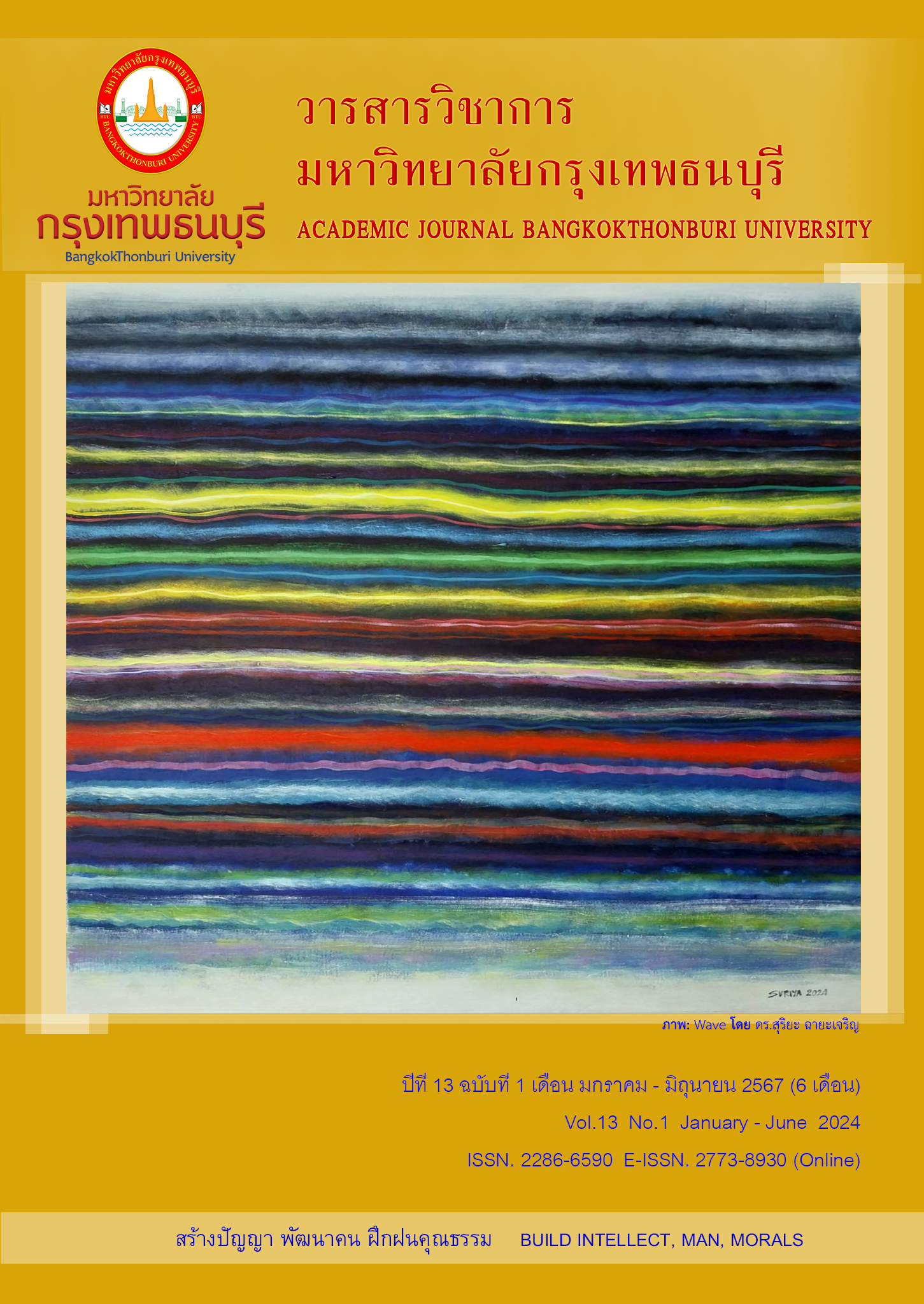Analysis of the relationship between places and spaces for displaying installation art: A case study of the works of 10 Thai artists from the Buddhist decade 1987-2017
Main Article Content
Abstract
The purpose of this article is to analyze the relationship of place and space for Installation Art in a case study of 10 Thai artists from the Buddhist decade 1987-2017.
The results of the analysis found that Installation Art comes from the construction of various objects. In a specific place and space to change the context of the place and space, both appearance and meaning, into a simulation of the world according to the artist's idea, presenting a new aesthetic experience. From the analysis of case studies of 10 Thai artists, it was discovered that Characteristics of the location and space must be consistent with the installation of Installation Art that is directed by the artist's ideas. The outstanding feature of Installation Art is to create a meaningful relationship between the displayed objects, their appearance and the meaning of the place, and the context of the area boundaries. By Installation Art, it can provide opportunities for viewers to interact with the area of the artwork as well.
Article Details

This work is licensed under a Creative Commons Attribution-NonCommercial-NoDerivatives 4.0 International License.
References
การท่องเที่ยวแห่งประเทศไทย, กรุงเทพมหานคร, และ มหาวิทยาลัยศิลปากร. (2541). มหกรรมศิลปกรรมแห่งเอเชีย เอเชี่ยนเกมส์ ครั้งที่ 13 กรุงเทพเมืองฟ้าอมร 2541: ศิลปกรรมกลางแจ้ง จิตรกรรม ประติมากรรม ศิลปะจัดวางในพื้นที่ โดย 78 ศิลปินร่วมสมัยไทย และ 8 ศิลปินจากเอเชีย-ยุโรป 8 ธันวาคม 2541-31 ธันวาคม 2542 ณ บริเวณเกาะรัตนโกสินทร์ชั้นนอก. กรุงเทพฯ: การท่องเที่ยวแห่งประเทศไทย.
ชลูด นิ่มเสมอ. (2558). สัพเพเหระเกี่ยวกับชีวิตและศิลปะ. กรุงเทพฯ: อัมรินทร์พริ้นติ้งแอนด์พับลิชชิ่ง จำกัด (มหาชน).
ธนะ เลาหกัยกุล. (2546). เส้น สี รูปทรง สังคมของการจัดวาง 40 ปี. กรุงเทพฯ: อมรินทร์พริ้นติ้งแอนด์พับลิชชิ่ง.
ภาณุ บุญพิพัฒนาพงศ์. (2560). นักเล่นแร่แปรธาตุแห่งวงการศิลปะ (1). เข้าถึงได้จาก มติชนสุดสัปดาห์ ฉบับวันที่ : https://www.matichonweekly.com/art/article_54141.
มหาวิทยาลัยศิลปากร. (2551). สูจิบัตรการแสดงศิลปกรรมแห่งชาติ ครั้งที่ 54. กรุงเทพฯ: มหาวิทยาลัยศิลปากร.
มานิต ศรีวานิชภูมิ, สุธี คุณาวิชยานนท์, และ อิ๋ง กาญจนะวณิชย์. (2544). นิทรรศการประวัติศาสตร์และความทรงจำ จัดแสดง ณ หอศิลปวิทยนิทรรศน์ จุฬาลงกรณ์มหาวิทยาลัย 15 สิงหาคม - 1 กันยายน 2544. กรุงเทพฯ: หอศิลป์วิทยนิทรรศน์ จุฬาลงกรณ์มหาวิทยาลัย.
สรรเสริญ สันติธญะวงศ์. (2560). ศิลปะในศตวรรษที่ 20. นครปฐม: โรงพิมพ์มหาวิทยาลัยศิลปากร.
สำนักงานปลัดกระทรวงวัฒนธรรม. (2559). ไทยเนตร. กรุงเทพฯ: สำนักงานปลัดกระทรวงวัฒนธรรม.
สุธี คุณาวิชยานนท์. (2563). Modern & contemporary art: the Western world & Thailand. กรุงเทพฯ: โครงการหนังสือตำราทฤษฎีศิลป์ ภาควิชาทฤษฎีศิลป์ คณะจิตรกรรมประติมากรรมและภาพพิมพ์ มหาวิทยาลัยศิลปากร.
สุริยะ ฉายะเจริญ. (2561). สภาวะเหนือความจริงในศิลปะแนวจัดวาง: กรณีศึกษานิทรรศการ “อันโดร เออร์ลิช: การเห็นและเชื่อ” ณ พิพิธภัณฑ์ศิลปะโมริ. วารสารศิลปกรรมบูรพา, 21(1-2), 165-186.
Atkins, Robert. (2013). ArtSpeak: A Guide to Contemporary Ideas, Movements, and Buzzwords, 1945 to the Present (3rded.). New: Abbeville Press.
Public Delivery. (2007). THAI ARTIST FAILED MISERABLY, OR DID HE NOT? – SAKARIN KRUE-ON. Retrieved June 28, 2019, from Public Delivery: https://publicdelivery.org/ sakarin-krue-on-terraced-rice-fields/.
QUEENSLAND ART GALLERY: GALLERY OF MODERN ART. (2019). Lotus sound 1992. Retrieved June 20, 2019, from The Queensland Art Gallery | Gallery of Modern Art: http://collection.qagoma.qld.gov.au/qag/imu.php?request=display&port=45001 &id=c674&flag=ecatalogue&offset=1&count=default&view=details#.
Sculpture Center. (2014, April 15). Subjective Histories of Sculpture: Araya Rasdjarmrearnsook. Retrieved June 27, 2019, from YouTube: https://www.youtube.com/watch?v= o5VX6OAda3M&fbclid=IwAR3x3a1Uk80zz7Vgxj3wt6rMG5-UdKO5Masf5SIpoX8ZB IewUWgTdli67rc.
Yap, June. (2013). Kamin Lertchaiprasert: Sitting (Money). Retrieved December 15, 2019, from Guggenheim: https://www.guggenheim.org/artwork/31322.


